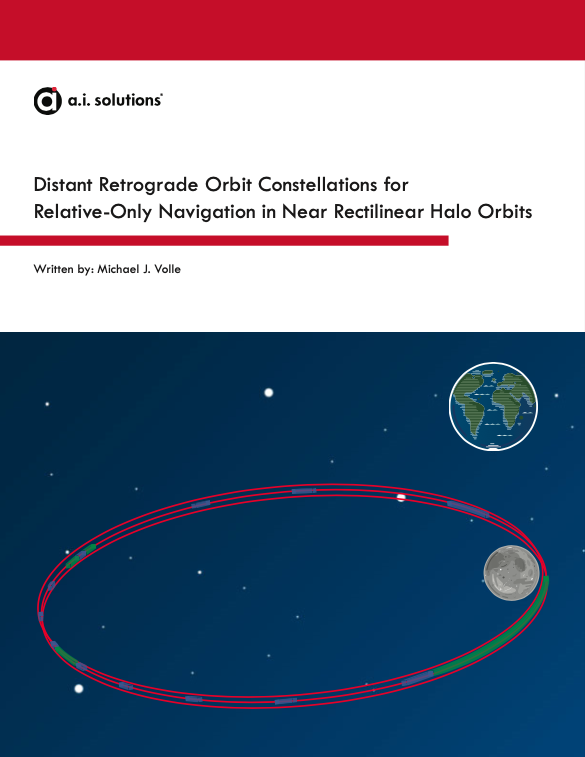
Automated
How are Distant Retrograde Orbits and Near Rectilinear Halo Orbits related?
NASA is currently working on the spacecraft and trajectory design for the Gateway mission that will reside in a Near Rectilinear Halo Orbit (NRHO). In the NRHO, Gateway will nominally require orbital maintenance maneuvers once per revolution. Separately, NASA is also working to develop technologies and techniques for relative navigation in cis-lunar space. Together, these concepts represent an opportunity for interesting research in cis-lunar navigation performance.
Introduction
The current plan for the Gateway mission is to operate in an L2 Southern Near Rectilinear Halo Orbit (NRHO) that is in a 9:2 resonance with the Moon’s orbit about the earth. The orbit has an average periapsis altitude of approximately 1800 km, an apoapsis altitude of 68,000 km, and a period of about 6.5 days.1, 2 The Gateway will be constructed over several missions, and its operational lifetime will have periods of both uncrewed and crewed activity. The quasi-periodic nature of the orbit in the Earth-Moon rotating frame ensures the orbit remains face-on with the Earth, and lunar blockages are eliminated. The NRHO orbit class is selected because it exhibits several useful advantages for human spaceflight.3-5
The class of Distant Retrograde Orbit (DRO) being considered in this work has an approximate X-amplitude of 75,000 km. There are many different size DROs with varying degrees of stability. Some DROs have been shown to be stable for tens to hundreds of years.6, 7 The DRO family also provides a unique geometry when paired with the NRHO, in that the primary planes of motion are essentially perpendicular to each other, when viewed in the Earth-Moon rotating frame. The DRO also provides a greater diversity of relative geometry than traditional DSN tracking provides. Figure 1(a) and 1(b) show the inertial and rotating views of the NRHO and DRO.
The Gateway mission is considering an orbit maintenance strategy that utilizes a receding-horizon approach for x-axis crossing control.5, 8 The high-level summary of the process is outlined as follows. Initially, a periodic NRHO in the Circular Restricted Three Body model is used to target a

(a) Moon-Centered Inertial frame

(b) Earth-Moon Rotating Frame
Figure 1: Inertial and Rotating Views of the NRHO and DRO
quasi-periodic NRHO in a higher-fidelity ephemeris force model. The resulting quasi-periodic orbits have been extended up to 15 years in duration, and are used as a source of targeting conditions for orbit maintenance maneuvers (OMMs). The receding-horizon approach then targets the reference Rotating Libration Point (RLP) frame x-velocity at periapsis multiple revolutions ahead of the maneuver planning state. These reference trajectories have been generated under both uncrewed and crewed orbital conditions.4
Typically, lunar or cis-lunar missions such as Gateway rely on the Deep Space Network (DSN) for some percentages of their tracking; however, as of 2015, the DSN supported approximately 40 deep-space missions and was routinely oversubscribed by about 30%. This demand translates to more than 500 hours of over-subscription per week, roughly equivalent to the work of 4 additional antennas.9 Furthermore, there are currently 6 more missions to Mars (comprising 9 spacecraft) planned for the 2020 launch window, creating an unprecedented level of demand.10 In an attempt to alleviate the expected congestion, the DSN has implemented the Multiple Spacecraft Per Antenna (MSPA) technique, allowing for shared antenna time. However, this is restricted to spacecraft within the same beam-width and all secondary spacecraft are limited to downlink only.11
Given this over-subscription, it makes sense to investigate alternative navigation strategies that might alleviate these scheduling constraints. Relative navigation approaches in cis-lunar space have been investigated previously, and they have demonstrated suitable navigation accuracies for robotic missions.12–14 In addition, NASA has contracted for additional studies on technologies related to peer-to-peer navigation in cis-lunar space.15 The previous works typically considered the combination of low-lunar orbit and Halo obits for the relative navigation scenario. More recent works have also begun to examine X-Ray based navigation (XNAV) for NRHOs and other three-body orbits.16 This analysis considers relative navigation between an NRHO and multiple DRO constellations.
The sum total of these characteristics (elongated/dynamic NRHO, crewed orbital disturbances, lack of geometric diversity with the DSN, DSN oversubscription) creates a challenging navigation scenario for Gateway. It also represents a unique opportunity to study the effectiveness of relative navigation in the cis-lunar orbital regime. This current work extends a previous work that examined relative-only navigation for Gateway using a single spacecraft in a DRO.17 This work improves upon the fidelity of the crewed disturbances by including attitude information, and modeling carbon dioxide (CO2) and waste dumps in body-fixed coordinates. The previous work modeled all crewed disturbances as constant magnitude impulses in a random direction. Secondly, this work ex-tends the DRO-based navigation concept to 2-, 3-, and 4-spacecraft constellations. Results obtained previously are briefly summarized and then compared to the newly-obtained results.
NASA is currently working on the spacecraft and trajectory design for the Gateway mission that will reside in a Near Rectilinear Halo Orbit (NRHO). In the NRHO, Gateway will nominally require orbital maintenance maneuvers once per revolution. Separately, NASA is also working to develop technologies and techniques for relative navigation in cis-lunar space. Together, these concepts represent an opportunity for interesting research in cis-lunar navigation performance.
To learn more, you can read our white paper “Distant Retrograde Orbit Constellations for Relative-Only Navigation in Near Rectilinear Halo Orbits”
Click the image below to download the white paper.



